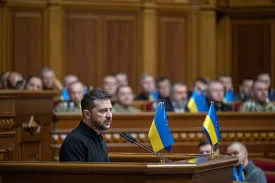
Ukraine’s Path to Victory: Military and Diplomatic Strategies
Ukrainian President Volodymyr Zelenskyy’s “victory plan” outlines the steps needed to defeat Russia and secure Ukraine’s future after nearly three years of war.
The plan, presented to Ukraine’s allies, focuses on military, political, diplomatic, and economic strategies. Key elements include securing more advanced weapons from Western allies, expanding Ukraine’s defense capabilities, and continuing the push for NATO membership, which remains a contentious issue with Moscow.
Zelenskyy emphasized the importance of quick decisions from allies to maintain Ukraine’s momentum, particularly in countering Russian advances and securing critical logistical points in the east.
Zelenskyy’s plan also stresses the need for a significant ramp-up in sanctions against Russia to weaken its defense industry and prevent future invasions.
His long-term vision is for a peace settlement that ensures Russia cannot rearm and launch further offensives.
Below is Zelenskyy’s plan:
1. Invitation to join NATO Even though actual membership is still an issue for the future, an invitation to join would send a strong signal to Russian leader Vladimir Putin.
“An invitation is a strong decision that requires nothing but determination,” the Ukrainian president said.
However, NATO Secretary-General Mark Rutte would not say if he’d rally allies to support Zelenskyy’s push for an invitation.
“The victory plan is not only about an invitation to become a member of NATO. The victory plan has more elements,” Rutte told reporters on Wednesday. “The next steps [are] not just on this issue, but on the general content of the victory plan.”
2. More weapons faster with no restrictions on their use
Ukraine has prepared a list of weapons to protect itself and to bring “war close to home for the Kremlin.”
It includes training and air defence capabilities to deter Russian attacks, real-time satellite data from allies, ending all restrictions on the use of donated weapons to strike inside Russia and help from allies in shooting down missiles and drones over Ukrainian territory.
Many of those steps have been blocked over Western fears of crossing Putin‘s red lines, but Zelenskyy argued that Ukraine’s advance into Russia’s Kursk region showed that Putin was fluffing.
“Thanks to the Kursk operation, we saw that Putin doesn’t have enough strength to hold his own when we push really hard,” he said.
3. Deterrence
Ukraine proposes to deploy on its soil a comprehensive non-nuclear strategic deterrence package that will be sufficient to protect Ukraine from any military threat from Russia. Faced with that, Moscow would either join an honest diplomatic process for a just end to the war, or it would face no longer being able to continue to fight thanks to the aid being given to Ukraine.
The exact weapons were not revealed by Zelenskyy in his speech to parliament, but he said leaders in the U.S., Germany, France and the U.K. know Kyiv’s asks.
4. Strategic economic potential
Ukraine proposes partners from the European Union and the U.S. sign a special agreement on common use of Ukraine’s critical resources, like lithium, gas, titanium and others, and produce energy together in the future.
5. Post-war perspectives
Ukraine would bolster European security thanks to its battle-hardened military.
Leave a Reply